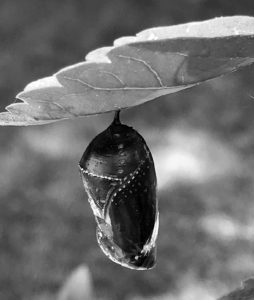Magnificent Monarch Butterflies Making a Slow Comeback
By Jude Mead
A memorable part of my childhood was spotting a monarch butterfly in late summer. The monarch is one of nature’s most spectacular species with its large size and recognizable bright orange and black markings.
Though once common in most gardens, today the monarch has become a rare sighting. According to Jane Seymour, a wildlife biologist and steward of the Wildlife Belding Management Area in Vernon, Conn., there has been a steady decline of the monarch butterfly for a number of years. “The downward trend happened pretty fast and has almost completely taken down the population of the once common monarch,” says Seymour. However, through the efforts of concerned citizens and conservation programs, the monarch is making a slow return to the area.

The pupa of a monarch butterfly. Photo by Gloria Gourley.
To understand the sharp decline of the monarch in recent years, you have to understand its life cycle and its dependence on an established pattern to survive. Monarchs undergo a metamorphosis. They begin life as an egg, hatch into the larval or caterpillar stage, then move to the pupal stage, becoming a chrysalis, and finally emerge as an adult butterfly.
Although each part of the life cycle is vital to its existence, the egg and caterpillar stages are the most important. The female monarch will only lay her eggs on one particular plant, milkweed. Seymour attributes the downward spiral of the monarch to the widespread loss of the milkweed plant. “Declining milkweed, declining monarchs. They have to have milkweed to exist,” she says.
Seymour explains that the egg the female deposits on the underside of a milkweed leaf hatches within five days into a wormlike larva, also known as a caterpillar. “The milkweed is its only food source. It will eat constantly on the plant for about two weeks as it grows and spins itself into a jade-green chrysalis,” says Seymour. In this stage, again, the milkweed is crucial because it is where the transformation into a butterfly is completed. The caterpillar spins a silk mat and hangs itself on the milkweed plant until the final stage of the cycle produces the adult monarch butterfly. The entire metamorphosis from egg to adult takes about one month.
What has caused milkweed to disappear from open fields? Seymour’s research attributes the problem to a lack of understanding of the critical role of the milkweed plant to the monarch. “Many people consider it a weed and pull it out or mow it down before a female has a chance to lay her eggs,” she says. She adds that the widespread use of pesticides and herbicides kills the plant.
To reverse the natural habitat loss Seymour recommends leaving the plants until breeding season is over or planting native milkweed and other nectar sources for the adult butterflies. “From small backyard gardens to farmers’ fields, everyone can do his part to help restore the plant. People can stop using chemicals, delay mowing areas where it grows, and they can even purchase native seed to plant,” suggests Seymour. She does warn, however, to buy seed that is native and not tropical, because that type can do more harm than good.
But loss of milkweed isn’t the only threat to the monarch. Monarch butterflies cannot survive long, cold winters. They fly south every fall in a migratory route that can be up to three thousand miles long. Seymour calls this phenomenon a wonder because migration is unusual for an insect, and unlike birds, the monarchs only make the trip once. “The monarchs that are seen during the summer here are not the same ones that wintered over in the south. As those monarchs begin the journey north, they go through the life cycle process along the route, breeding and laying eggs, sometimes going through three or four generations before reaching us. We may even get a fifth generation here to start the cycle again,” explains Seymour.
This migration poses another danger to the monarch population. “The monarchs migrate to one very small area in the mountains of central Mexico. It is a mystery [to us] how they find the same place to migrate to each year knowing that it is not a learned route, since the same ones do not return. Food sources have dwindled along the way, and much of the area where they roost has been destroyed by illegal logging, leaving the butterfly exposed to winds and cool temperatures,” says Seymour.
Monarchs have other natural enemies, such as parasites and disease, but hope is not lost for the magnificent monarch. Seymour says that if everyone participates in helping, the monarch will make a comeback. “It will take several years for the monarch to recover from its losses, but the trend is turning. While counts have been going up, the monarch has a way to go before full recovery,” she says. Some ways to speed that up, she adds, are to stop cutting milkweed back until after the breeding season, to plant more native milkweed, plus plenty of nectar sources for the adult monarch, and to stop using insecticides and herbicides on or near the monarch’s food sources. If we follow these simple rules, the monarch may once again become a common sight in backyard gardens.
Photo, top, of a monarch butterfly feeding on a cone flower, by Bruce Frisch.

